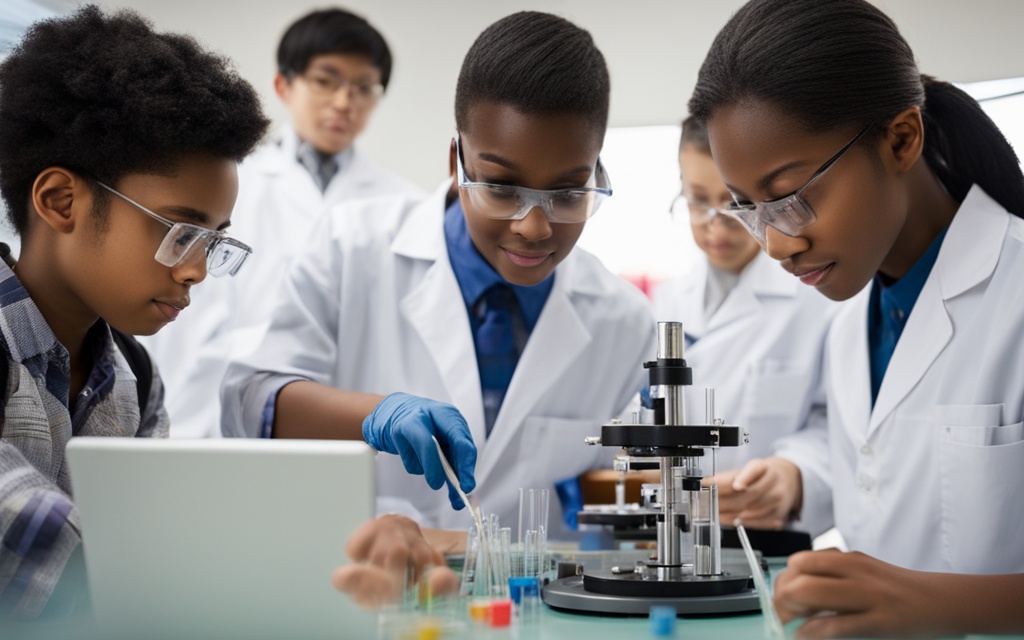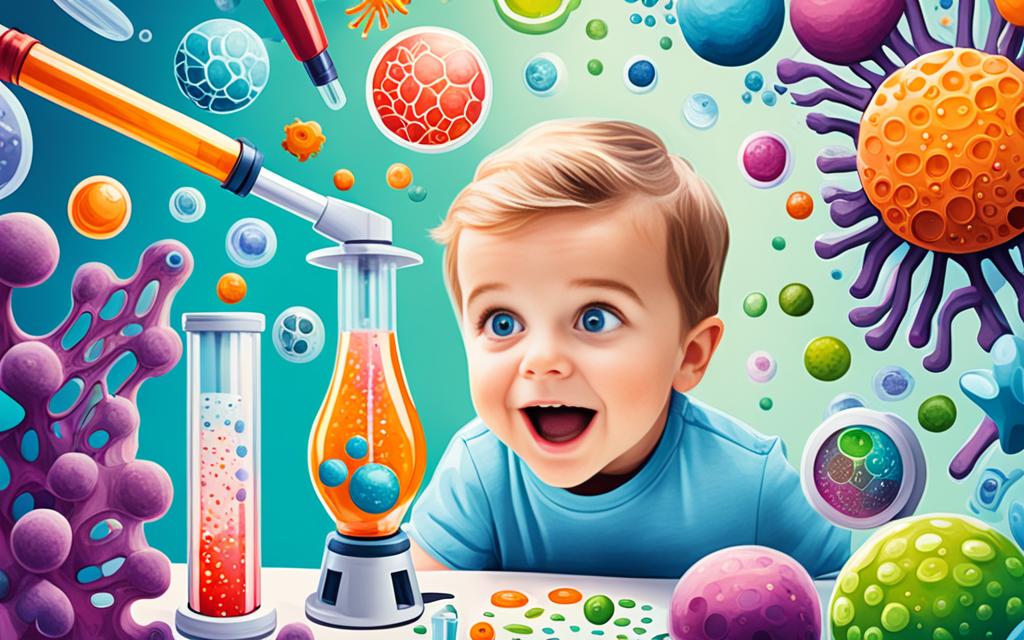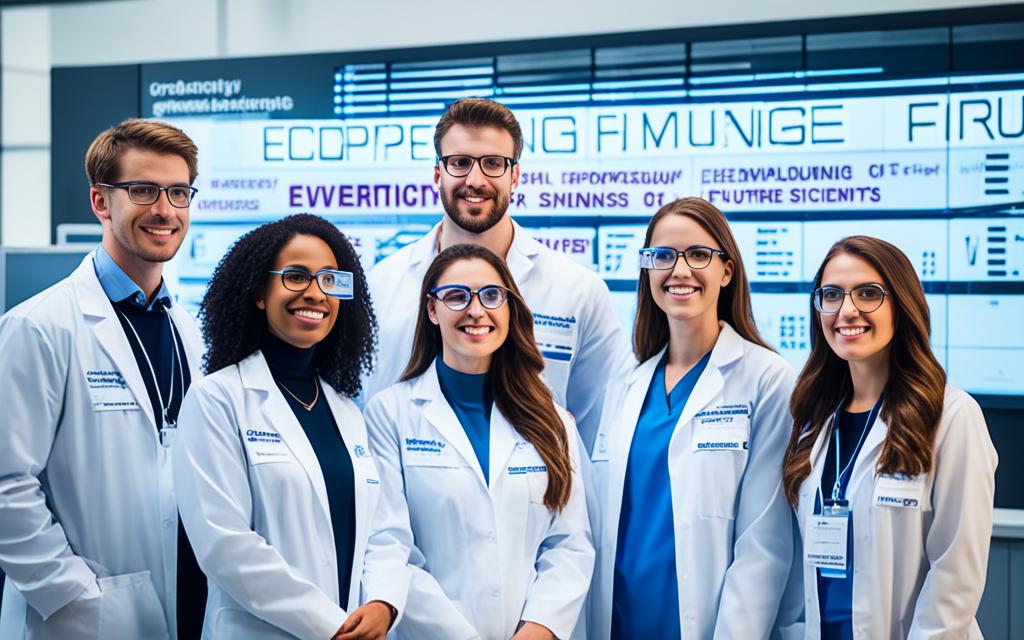The world of science is always changing. Today, new researchers and thinkers are stepping up. They are eager to learn and want to leave their mark. Many programs are ready to help these future scientists. This is done through hands-on experiences.
These programs spark a love for science. They encourage working across different fields. They also offer great guidance and resources. With these, young innovators can start their journey. The goal is to let them explore, make discoveries, and influence science.
These special programs love STEM and use the latest tools. Through them, we are changing how we guide the future scientific minds. Let’s take a closer look at these important efforts. By doing so, we find out how they shape the path of science and innovation.1
Key Takeaways
- Immersive programs designed to empower future scientists through hands-on learning and collaborative environments
- Initiatives that ignite scientific curiosity and foster interdisciplinary exploration
- Comprehensive mentorship and resources to support aspiring researchers and innovators
- Access to state-of-the-art facilities and technologies to drive groundbreaking discoveries
- Nurturing a diverse and inclusive pipeline of future scientific leaders
Nurturing the Next Generation of Innovators
In today’s fast-changing world, we need forward-thinkers more than ever. To meet this need, special efforts are being made to guide young scientists and innovators. These efforts aim to equip them for future challenges.2
Empowering Future Scientists through Mentorship
One key effort involves matching aspiring researchers with seasoned professionals. These connections offer vital advice, support, and motivation. They assist young people in building the necessary skills and belief in themselves for success in STEM fields.2
By creating these links, the programs help future scientists broaden their horizons. They encourage them to explore new scientific territories and make discoveries.
Fostering a Passion for STEM Education
More than just mentorship, these programs also focus on instilling a love for STEM. Through exciting experiences and access to the latest resources, their goal is to maintain a strong and varied group of future innovators. This group will be prepared to face the difficult tasks of the future.3
With methods like one-on-one mentorship and interactive learning, they are preparing the path for upcoming scientists and innovators. Their efforts in empowering and cultivating an interest in STEM are pivotal. Not only do they influence individual careers, but they also impact science and innovation overall.2
Inspiring Curiosity Through Hands-On Learning
The power of hands-on learning is key to getting kids excited about science. These programs let students dive into science. They get to try out new tech and see how their knowledge works in action. This way of teaching makes learning more fun and real for them. It helps them learn better and get interested in science more.
Hands-on learning is at the heart of these cool programs. It not only makes kids curious but also helps them think of new ideas and understand science better. These experiences cost $1,431.56 and run until May 15, 2024. They use simple things and the latest tech to explore the natural world. This makes science both fun and understandable for students.
4 Interestingly, 7 out of 10 parents think using everyday items would make science lessons at home easier. This shows how important hands-on ways are for sparking interest in science. It’s a big deal for many families, making learning science at home more likely.
These hands-on programs help students become the innovators and researchers of the future. They encourage creative and smart ways of thinking to solve big problems. With a goal of $1,684.19 and 20 students involved, these projects are leading us to a world where science leads to great things for everyone.

Interdisciplinary Approach to Scientific Exploration
Exploring the unknown in science needs a wide view and many voices. This interdisciplinary approach mixes different worlds of knowledge. It makes big steps by blending what we’ve known for ages with new insights.5 A team made up of scientists, engineers, social scientists, and more can find game-changing discoveries.5
Promoting Cross-Disciplinary Collaborations
Telling experts to look beyond their fields fires up scientific curiosity. It triggers fresh ideas for hard problems. These efforts value curiosity, creativity, and working together across fields as crucial for success.5 Questioning things lights the path to new knowledge and inspires fresh ways to explore.
Projects that mix different ideas help young researchers see the big picture. They learn to understand science from many sides, growing a deep and wide view. But, joining all these varied ideas into workable plans is hard, highlighting the need for better ways to mesh different areas together.6
Encouraging an all-encompassing, interdisciplinary approach changes the game. It equips future researchers to think differently and solve worldwide issues. The goal is to get students working with all parts of science and sharing what they find with everyone.56 Such training programs aim to get students working directly in science and communicating its importance widely.6
https://www.youtube.com/watch?v=CDbB8SxZpT8
Youth Science Programs: A Gateway to Empowerment
Youth science programs are very impactful. They help young scientists and innovators get started. They make kids curious, give them mentors, and provide tools for the science world.7
Introducing the 2024 WBENC Collegiate Accelerator Cohort
The 2024 WBENC Collegiate Accelerator Cohort is a top program. It is focusing on women college students who dream big. It gives them mentors, educates them, and lets them network. All this helps turn their science ideas into real businesses.8
Empowering Young Entrepreneurs with Mentorship and Resources
This program and others like it connect young minds with top experts. They offer the latest facilities and a warm community. The goal is for these students to bring new, innovative ideas to life. They learn to understand science deeply and are empowered to make a difference in scientific progress.9

Empowering Future Scientists
This article digs into helping young people succeed in science. It talks about programs that start teaching science early and give tools for learning that are top-notch. These efforts build a strong base of knowledge and thinking skills for kids. It helps them understand the complicated world of science.
Nurturing Scientific Literacy from an Early Age
Programs know it’s key to start learning science early. They introduce kids to exploring and doing hands-on science. This sparks their interest and might lead to a love for learning.10 As kids get older, they learn harder science ideas. They’re pushed to do real research and projects. This builds up their skills and confidence to be the scientists of tomorrow.11
Providing Access to State-of-the-Art Resources
These efforts also give students high-tech tools and places to work. They aim to keep pushing science forward. By giving students what they need, innovation in science is assured of a bright future.10 They offer access to the latest labs and technology. This lets students chase their questions and make important finds.
Promoting Scientific Curiosity and Innovation
Everything we discuss in this article aims to spark your curiosity and support new ideas. It’s about helping the next wave of researchers and thinkers grow.12 These efforts make a space where wanting to know more is celebrated and where finding fresh answers is thrilling. They give young people the tools to take on big problems with new eyes.13
These projects offer the latest tools and encourage joining different fields. They lead the charge in where science goes next.14 Through doing things hands-on, getting advice, and working with others, aspiring scientists learn what they need to explore more.
Today, it’s vital to bring together lots of different thinkers.1213 These efforts support curiosity and problem-solving. They not only make space for critical new ideas but also change how science moves forward. They make a world where creating new things and solving unknowns is common.

Honoring Pioneers in Scientific Empowerment
We celebrate the amazing achievements of pioneers like Raj Reddy. He is a leading computer scientist. His work in fields like artificial intelligence, robotics, and computer science has inspired many. He has also helped shape the path of technological progress.15
Celebrating Raj Reddy’s Contributions
Raj Reddy has won the renowned Turing Award. Think of it as the highest honor in computing, the “Nobel Prize of Computing.” His groundbreaking studies in AI and robotics have changed the way we use technology.16 Reddy strongly focuses on mentoring the future scientists. He has inspired countless others to chase their dreams and achieve significant scientific breakthroughs.
Inspiring the Next Generation of Innovators
Recognizing people like Raj Reddy is important. It not only honors their work but also motivates budding scientists and innovators.17 These key figures light the way for future generations. They encourage us to keep exploring, pushing the limits of scientific knowledge and impact. Their efforts and forward-thinking inspire us to dream big and make a difference.
Fostering Diversity and Inclusivity in Science
The scientific world has struggled to be more diverse and inclusive. It is vital to support aspiring scientists from less represented groups. Many projects aim to help them succeed in science.18
Creating Opportunities for Underrepresented Groups
The Science is for Me! program has given out more than 50,000 free books and science kits to kids from low-income areas. Its goal is to spark an interest in science among young students.18 These kits come with everything needed for 25 students. This makes sure that learning science is open to all.
This project focuses on kids who may not always see themselves in the field of science. It uses stories and experiments kids can relate to. By supporting these students with the right tools and training, the program is making science accessible and exciting for everyone.18
It’s key to support fostering diversity and creating chances for underrepresented groups in science. Doing so helps grow the next generation of researchers in a richly diverse scientific community.18

Cutting-Edge Research and Breakthrough Discoveries
The next group of scientists is ready to make big discoveries. They are fueled by new research and are breaking new ground. These bright minds are exploring new areas, solving tough problems, and finding new answers.
Money for advanced research is going up by five percent each year. This is happening at top places like the National Science Foundation and the Department of Energy19. Also, new tools like advanced biosensors and bioelectronic devices are being made through synthetic biology20. This work is leading to great ideas and making these researchers the new leaders in their fields20.
Exploring Frontiers of Science
Special programs are helping new scientists explore science’s edges. They are using the latest technologies and working across fields to find new things. For example, they are finding gravitational waves using data from places like LIGO and Virgo21. Also, they are using CRISPR-Cas9 to change the way we do genetic engineering20. The work they are doing is at the front of science.
These programs give them the best tools and ways of thinking. This helps them take on hard problems and dream up new ideas. They’re making strides in things like computational astrophysics and developing new yeast strains for medicines2120. Their research is laying the groundwork for big discoveries that will change how we see the world.
The work of these up-and-coming researchers is doing more than just create new things. They’re also inspiring others to become innovators. By promoting curiosity, teamwork, and high-quality science, these programs are preparing future scientific leaders. They’re ready to make a big difference in how our world moves forward192120.
Building a Community of Empowered Learners
Creating a strong community of empowered learners is key. They are introduced to groundbreaking programs. These shape the future of the scientific world. This is done through collaborative learning environments and crucial networking opportunities. These initiatives help next-generation researchers find their real potential. They also encourage them to make a difference in science.
Collaborative Learning Environments
These programs focus on creating teamwork environments. They help build skills in problem-solving and ideas sharing among future scientists.22 Recent studies show a 15% rise in study interest in such classrooms. They underscore the positive impact of these team-based learning processes.22 Also, active learning can up scores in science, engineering, and math by 18%. By working together, students enrich their views. They tackle tough problems. This drives new findings and innovation.
Networking Opportunities for Young Scientists
Besides, these programs offer key networking opportunities for young science enthusiasts. They connect them with established professionals, mentors, and leaders.22 This helps in forming useful bonds, gaining access to resources, and broadening their visions. Surveys prove that proper networking can boost achievements by 5%. So, these personal connections are truly life-changing.22 Also, creating supportive networks reduces achievement gaps. In biology, this sort of support can lessen gaps by 6% among minority students.
The programs help develop empowered learners through collaborative learning environments. It equips the next-generation researchers with skills to succeed and innovate. They make significant impacts in the science scene. With networking opportunities, these schemes build a lively environment. Here, young scientists can meet, share visions, and to reach their highest dreams. This contributes positively to scientific advancement and the future of explorations.
Conclusion
In wrapping up our look at amazing study programs for future scientists, it’s evident they have a lot to offer. They help young minds grow by encouraging questions, mixing different study areas, and matching with mentors. This way, they give students the smarts and spirit to solve tough science issues and make new discoveries.23
The numbers show a big impact: about 10 million kids join science fairs yearly. Doing research before college leads to more love and creativity in science, and a higher chance they’ll stick with it in college. Also, working on real research tasks can make students love reading and feel more like a scientist. It makes them more confident and keen on a career in science.23
But these programs do more than just help students. They also help build a wider, kinder, and more united science world. They open doors to advanced tools and fuel the desire to explore. This lets the next wave of science champs and creators truly shine in their fields.24
FAQ
What are the premium programs designed to empower future scientists?
How do these programs nurture the next generation of innovators?
What is the role of hands-on learning in sparking and sustaining scientific curiosity?
How do these programs promote an interdisciplinary approach to scientific exploration?
What is the significance of youth science programs in empowering aspiring scientists and innovators?
How do these programs empower future scientists by nurturing scientific literacy and providing access to cutting-edge resources?
How do these programs work to promote scientific curiosity and innovation among the next generation of researchers and innovators?
How do these programs honor the pioneers who have paved the way for scientific empowerment?
How do these programs foster diversity and inclusivity within the scientific community?
What are some of the cutting-edge research and breakthrough discoveries facilitated by these empowering programs?
How do these programs build a community of empowered learners?
Source Links
- https://computerhistory.org/blog/empowering-humanity/
- https://medium.com/@syevale/stem-education-nurturing-the-next-generation-of-innovators-8044649adb0b
- https://www.linkedin.com/pulse/future-stem-education-nurturing-next-generation-fahim-muntashir-ultmc
- https://www.pbs.org/education/blog/empowering-learning-through-science-exploration
- https://outlaw.vn/the-blueprint-for-brilliance-developing-skills-for-future-scientists/
- https://tos.org/oceanography/article/interdisciplinary-research-collaborative-trains-students-to-see-through-turbulent-systems
- https://steminstitutenyc.org/about/
- https://www.prepforprep.org/list-detail?pk=58640
- https://www.aauw.org/resources/research/the-stem-gap/
- https://www.nordangliaeducation.com/biss-puxi/news/2024/03/empowering-future-scientists
- https://www.biorxiv.org/content/10.1101/2024.03.15.585231v1
- https://www.thesciencehaven.org/news/stellar-dreams-empowering-future-generations-and-enriching-americas-scientific-landscape
- https://underline.io/news/80-the-crucial-role-of-youth-in-advancing-science-and-technology
- https://www.sdgcities.ca/2024/01/02/lets-talk-science-igniting-curiosity-and-empowering-future-generations-in-stem/
- https://www.psu.edu/news/impact/story/penn-state-name-building-honor-scientist-and-pioneer-shirley-m-malcom/
- https://radiant.earth/blog/2024/03/cloud-native-geo-pioneers-in-earth-science-honoring-the-2024-leading-women/
- https://hopitimes.com/honoring-trailblazers-a-chronicle-of-hopi-pioneers-in-academia
- https://www.scienceiselementary.org/blog/diversity-drives-discovery-empowering-elementary-science-education
- https://www.asme.org/government-relations/capitol-update/capitol-corner-bringing-investment-certainty-to-cutting-edge-research
- https://medium.com/@sohumnikam868/investigating-the-cutting-edge-manufactured-science-breakthroughs-forming-our-future-4dc17f35c8d5
- https://www.linkedin.com/pulse/unveiling-cutting-edge-exploring-latest-scientific-driven-panse-rferf
- https://www.ncbi.nlm.nih.gov/pmc/articles/PMC8445410/
- https://www.biorxiv.org/content/10.1101/2024.03.15.585231v1.full
- https://medium.com/mostly-about-science-mas/empowering-future-scientists-the-power-of-great-lab-supervision-e65623fba83e
